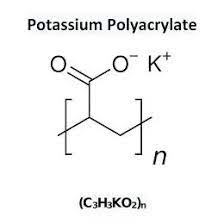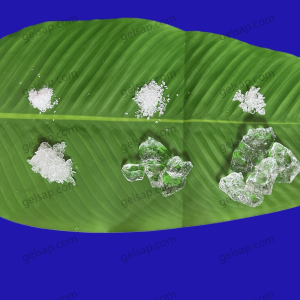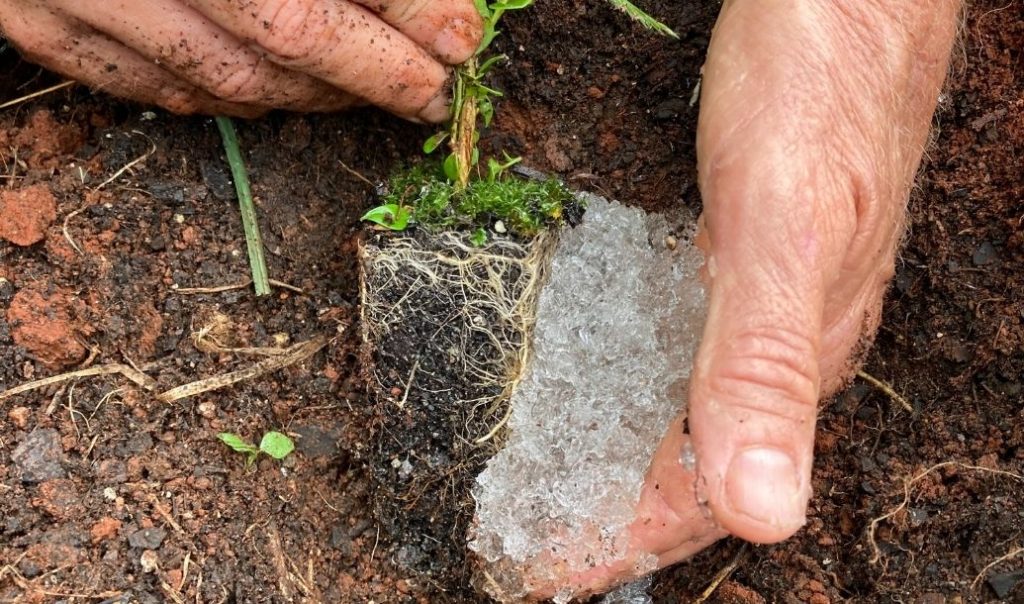Superabsorbent polymers (SAPs) are advanced physical absorbent materials capable of rapidly absorbing large amounts of water and locking it firmly. When saturated, they transition from a powder or granular state to a hydrogel.
Generally, SAPs can absorb hundreds, or even thousands, of times their own weight in water. They are eco-friendly, non-toxic, harmless, and non-polluting materials.
Что такое полиакрилат калия?
Potassium polyacrylate is a type of SAP used for plants as a water-retaining agent. Compared to ordinary SAP, agricultural-grade potassium polyacrylate has undergone post-processing, such as grafting, making it uniquely suitable for agricultural applications.

Key Advantages of Полиакрилат калия in Agriculture:

Change in Cation: Potassium polyacrylate replaces sodium ions with potassium ions, eliminating the risk of soil salinization and fertilizing the soil with potassium ions after decomposition.
Improved Water Absorption: It significantly enhances the soil’s absorption capacity for high-concentration ionic liquids (soil leachate) under soil pressure.
Extended Decomposition Time: While ordinary SAPs decompose within a month or so, agricultural potassium polyacrylate can repeatedly absorb and release water in the soil for many months.
Soil Improvement: After natural degradation, it breaks down into ammonium nitrogen, water, and a small amount of potassium ions, effectively enhancing soil quality.
These advantages effectively turn potassium polyacrylate into a “mini-reservoir,” absorbing and storing water during rainy seasons or irrigation and continuously providing water to plants during dry periods.
Practical Benefits of Полиакрилат калия in Agriculture:
- Enhances seed germination and emergence, promoting early and healthy plant growth.
- Acts as a slow-release fertilizer.
- Improves soil water holding capacity, particularly beneficial for sandy soils where water retention can be increased by up to 85%.
- Increases crop and fruit production significantly, as demonstrated by a 70% increase in melon yield in California.
In summary, potassium polyacrylate offers substantial benefits for agriculture, contributing to improved water management, soil quality, and crop productivity.
How It Works?
Agriculture-grade SAP (Superabsorbent Polymer) comprises a network of polymeric chains arranged parallel to each other and interconnected by cross-linking agents. When water encounters one of these chains, it is drawn into the molecule via osmosis. The water rapidly permeates into the interior of the polymer network, where it is stored. This process transforms SAP powder into a water gel.
Due to its greater absorption capacity compared to soil but lesser than plant roots, the absorbed water by SAP is released to plants when the surrounding soil becomes dry.
Note: The specific retention of agricultural SAP is 1.3-1.4 MPa, while the specific retention of roots is approximately 1.6-1.7 MPa.
Potassium Polyacrylate Water Holding Capacity Test
Objective: Performance study in varying soil classifications to assess the water retention capacity of SAP in different soils.
Sample Volumes Used:
Soil: 500ml
Water: 750ml
SAP: 5 grams

Test 01 – Soil Type: 100% Sand
| Test item | Control Group (without SAP) – 762g | Test Group (with SAP) – 768g |
| Water passing (ml) | 425 | 150 |
| Water retaining (ml) | 325 | 600 |
| % retaining | 43.3 | 80 |
| % increase | – | 85 |
Test 02 – Soil Type: 37% Sand + 40% Silt + 25% Clay
| Test item | Control Group (without SAP) – 615g | Test Group (with SAP) – 626g |
| Water passing (ml) | 275 | 100 |
| Water retaining (ml) | 475 | 650 |
| % retaining | 63.3 | 86 |
| % increase | – | 36 |
Test 03 – Soil Type: 30% Sand + 48% Silt + 22% Clay
| Test item | Control Group (without SAP) – 407g | Test Group (with SAP) – 400g |
| Water passing (ml) | 352 | 200 |
| Water retaining (ml) | 398 | 550 |
| % retaining | 53.1 | 73.3 |
| % increase | – | 38 |
How to use potassium polyacrylate?
Using Potassium Polyacrylate
For Perennial Plants
- The primary method for perennial plants (such as fruit trees, tea, forests, bananas, mulberries, sugarcane, medicinal plants, and bamboo shoots) involves a technique known as “dipping root + base application.”
- “Dipping root + base application” entails immersing seedling roots in a hydrogel (consisting of potassium polyacrylate + water) mixed with fine-grained water-retaining agents. After water absorption, large-grained gel agents are added during backfilling of the planting hole.
This method prevents seedlings from dehydrating during planting and provides an easily absorbed water source during the critical period of seedling rooting, thereby shortening the slow seedling period.
Transplanting

- Root Dip
- Mix potassium polyacrylate water-retaining agent (80100 mesh) with fine soil at a ratio of 1:51:10 and place them into a large non-metallic container.
- To ensure sufficient water absorption by the water-retaining agent, add about 100-150 times the weight of potassium polyacrylate water (rooting powder can be added simultaneously) 6-20 hours before dipping the roots. Mix and stir to form a gel or colloidal mud.
Then, use this mixture for dipping the roots of seedlings for afforestation. When dipping the roots, single or multiple plants can be used, with no more than 50 plants at a time. Ensure that the roots of seedlings are completely immersed in the gel or gelatinous mud to fully dip them.
Cuttage Seedlings in Seedbeds
A. Direct Use
Evenly mix 5~15g of potassium polyacrylate particles per square meter on the seedbed. Level the seedbed and cover it with a thin layer of fine soil. Dip the base of the branch into the root, then cut it on the seedbed, and water it.
B. Stir with Water to Form a Hydrogel Before Use
Mix the gel agent accounting for 1/5~3/5 of the total mass of the matrix soil into the matrix soil on the seedbed and mix evenly. Level the seedbed and cover it with a thin layer of fine soil. Dip the base of the branch into the root, then place the cutting on the seedbed, and water it.
Culture Bag Seedling
A. Direct Use
Add 0.1%~0.3% dry product of water-retaining agent into the culture medium, mix it evenly, and pack it into bags. Water immediately. Suitable for sowing, budding, transplanting, and raising seedlings.
B. Cell Building
Add the gel agent that accounts for 1/5~3/5 of the total mass of the culture medium into the culture medium, mix it evenly, and pack it into bags. Water regularly. Suitable for sowing, budding, and transplanting seedlings.
Base Application
A. Direct Use
Sprinkle potassium polyacrylate particles directly into the dug holes. Mix well with the fine soil at the bottom of the hole. Then move the rooted saplings, cover with soil in a concave shape (to collect water), and immediately water enough water.
B. Stir with Water to Form a Hydrogel Before Use
The gel is applied into the dug hole and then fully mixed with the fine soil at the bottom of the hole. Then move the rooted saplings and cover them in a concave shape (to collect rainwater). Immediately pour the root water again.
Applying Potassium Polyacrylate
- Прямое применение
Sprinkle potassium polyacrylate particles directly into the dug ditch, fully mixing them with the fine soil in the ditch at a ratio of 1:1000. Cover the soil (avoid stepping on it) into a concave shape to collect water, then immediately water it thoroughly.
- Pre-Mixed Application
Prepare a gel by mixing potassium polyacrylate and water, then apply it into the dug ditch. Mix the gel with the fine soil in the ditch at a ratio of 1:5. Cover the soil (do not step on it) into a concave shape to collect rainwater. Then pour water once.
- Using Potassium Polyacrylate with Fertilizer
When applying the water-retaining agent and fertilizer together, two methods can be employed:
- Staggered Ditch Method
Dig a ditch in the middle of two plants. Apply water-retaining agent on one side and fertilizer on the other side of the ditch.
- Both Sides of the Plant Method
Dig ditches on both sides of the plant. Apply water-retaining agent on one side and fertilizer on the other side.
In both methods, the water-retaining agent is placed on top, while the fertilizer is placed at the bottom of the ditch. This ensures that plants can absorb both nutrients and water effectively.
Note: The depth of the ditch should be more than 40cm to accommodate the water-retaining agent, which may decompose due to microorganisms. The deeper the water-retaining agent is buried, the deeper the plant’s roots will grow, leading to a more solid and developed root system.
For Annual Crops
Below are the usage methods for annual crops (grains, vegetables, cotton, fodder, melons, beans, tobacco, mushrooms, peanuts, etc.):
Coated Seed Dressing
Wet Mix Coating
Mix seeds with a gel-like water-retaining agent (made by mixing 80-100 mesh water-retaining agent with water). Spread the mixture indoors to dry in the shade or pile it up for 1 to 8 hours. Ensure there is no adhesion between the seeds and a layer of coating is formed on the surface. Small seeds such as millet should be lightly rubbed to disperse after drying in the shade or mixed with fine soil. The ratio of water-retaining agent, seeds, and water is 1:500:200.
Seed Treatment Methods
- Dry Mix Coating
Soak the seeds in water for at least 3 hours.
Remove the seeds and allow them to dry until the surface is moist but not sticky.
Sprinkle the water-retaining agent (80~100 mesh) onto the surface of the seeds at a ratio of 1:1000.
Thoroughly coat the seeds by repeated vibration or rubbing.
Sow the coated seeds into the soil.
- Fluid Seeding
Mix a suitable amount of water-retaining agent and water to create a hydrogel at a ratio of 1:300.
Combine the hydrogel with the seeds and mix well.
Sow the seeds into the soil using a specialized fluid seeder.
- Seedbed Preparation
Mix a gel agent (dry product 5~8g/m², approximately 0.1% of the soil layer) with 1/5 of the total weight of the planting layer.
Apply this mixture to the seedling raising soil ridge (furrow) and the planting layer soil.
- Mix the gel with fine soil after sowing.
Cover the surface with pure soil without water-retaining agent.
- Base Application for Crop Planting
Apply 1~2kg of potassium polyacrylate gel per square meter evenly into the planting ditch.
- Mix the gel thoroughly with the soil in the ditch.
- Cover with soil after planting.
- Topdressing for Planted Crops
Dig a parallel trench at a distance of 5-20cm from the main stem of the plant, ensuring it is more than 40cm deep to reach the root distribution layer.
Evenly sprinkle 1~2kg of potassium polyacrylate gel per square meter into the trench.
- Mix well and cover with soil.
- Edible Fungus Cultivation
Prepare the edible fungus culture material according to standard procedures.
Add approximately 50% of the dry cultivation material along with the water-retaining agent hydrogel, mixing thoroughly.
Preferably, pile and ferment the cultivation materials before bagging and sterilizing for cultivation, or directly cultivating.
Utilize the water-retaining agent hydrogel to retain water in the covering soil layer, promoting a balanced water supply and stimulating mushroom growth.
Utilize the water-retaining agent’s ability to absorb and release water for recycling and cultivation of cultivated fungus waste after fermentation.
Gardening Techniques
- Root Dip
Before planting, immerse flower seedlings’ roots into a gel made by blending the dry product of an 80-100 mesh water-retaining agent with water.
Potted Planting
- Mix 1 part of gel with 2~5 parts of soil, adjusting based on the crop’s water requirements.
- Place a small portion of the mixture at the bottom of the flowerpot.
- Plant the seedling and fill the pot to 70% capacity.
- Cover the surface with more than 2cm of pure soil.
- Topdressing with Grow Bags and Pots
- Drill holes around the roots to the depth of their concentration.
- Fill the holes with a mixture of water-retaining agent and fine soil at a ratio of 1:10.
- Cover with a thin layer of soil and water thoroughly.
Trees and Shrubs
- Apply 0.5~1kg of gel per square meter according to the green belt area, mixing it with the root soil before planting.
- Cover with soil and water after planting seedlings.
- Topdressing of Trees and Shrubs
For Flower Shrubs:
- Dig a ditch with a width and depth of more than 20 cm to the root distribution layer, 10 to 30 cm from the trunk.
- Apply 0.5~1kg/m² of polypropylene high-potassium gel, mixing it with one-third of the excavated soil, and spread it evenly. Cover with soil, shaping a concave to collect rainwater.
For Arbor:
- Dig 3 to 6 pits within the crown drip line, each with a width and depth of more than 20 cm.
- Apply 0.5 to 5 kg of gel agent per plant on average. Cover with soil.
Long-Distance Transplanting of Trees
After long-distance transportation for dozens of hours, use a gel agent (80~100 mesh dry product of water-retaining agent) mixed with water. Add an appropriate amount of humus and rooting agent to create a thick slurry. Dip the roots completely and wrap with film to guarantee a survival rate of over 98%.
Base Application
When planting, apply 5~100kg of gel in the pit. Place arbors whose roots have been dipped in potassium polyacrylate hydrogel. Cover with soil and water thoroughly.
For Lawn
For New Lawn
- Mix potassium polyacrylate with water to form a hydrogel.
- Apply the hydrogel evenly on flat land at a rate of 1~1.6kg of potassium polyacrylate per square meter.
- Fully incorporate the hydrogel with an equal amount of fine soil and spread it evenly.
- Plant the turf after lightly covering with clean soil.
For Existing Lawn
- Use multi-toothed nails to poke the lawn, creating relatively uniform small holes.
- Evenly spread 5~8g/m² of water-retaining agent particles.
- Use slightly pressured water to flush the granules of the agent into the small holes.
- Water thoroughly for the first day or two.
With Slow-Release Fertilizer
Удобрение с медленным высвобождением
- Dissolve several water-soluble fertilizers such as urea, auxin, and root agents (avoid strong acid and alkaline products) in water.
- Add potassium polyacrylate particles to the solution to absorb it, creating a slow-release fertilizer.
- This method prevents the loss of fertilizer and achieves balanced water supply, fertilization, and medication, significantly improving efficacy and saving fertilizer.
Bacterial Fertilizer Activator
- Biological fertilizers require soil moisture to activate and reproduce bacteria.
- Mix this agent with biological bacterial fertilizer to enhance efficacy and efficiency, saving fertilizer.
Frequently Asked Questions
Is Potassium Polyacrylate Safe?
Safety Hazards to Humans,Potassium polyacrylate is non-toxic to the human body, with a neutral pH value of 7.
It’s important to note that the preparation of potassium polyacrylate involves the polymerization of potassium hydroxide and acrylic acid. However, the finished product contains very little acrylic residue.
Excessive acrylic acid can cause irritation to human skin, especially the eyes. Manufacturers provide Material Safety Data Sheets (MSDS) for potassium polyacrylate, ensuring that the residual amount of acrylic acid meets safety requirements.
Example of Material Safety Certificate for Potassium Polyacrylate
Other Safety Concerns
- Aside from concerns related to acrylic acid, there are other safety considerations due to the characteristics of potassium polyacrylate.
- Potassium polyacrylate, as a super absorbent polymer, has a water-swelling characteristic and should be used carefully.
- In its small particle form, potassium polyacrylate powder can irritate the lungs and upper respiratory tract if inhaled.
- If ingested accidentally, potassium polyacrylate can absorb water and swell in the stomach and intestines, leading to indigestion.
- Potassium polyacrylate, once it absorbs water and forms a hydrogel, may become slippery if left on the ground.
Environmental Safety Concerns
As an agricultural water retention aid, potassium polyacrylate is not harmful to the environment. Although it’s not biodegradable in its conventional form, it can naturally degrade into water, ammonia, and carbon dioxide in the environment.
In countries with strict environmental regulations, manufacturers may improve the process by grafting starch onto potassium polyacrylate to make it biodegradable.
Note:
Some unscrupulous manufacturers may sell sodium polyacrylate as potassium polyacrylate due to the lower market price of sodium polyacrylate. Sodium polyacrylate can cause soil compaction and salinization, so it’s essential to be cautious when making purchases.
Disadvantages of Potassium Polyacrylate
- Potassium polyacrylate may not be suitable for all arid agricultural and forestry environments. Before purchasing, it’s essential to consider the following factors:
- Impact of Environmental Conditions: The water absorption and retention capacity of potassium polyacrylate are significantly influenced by ambient temperature and soil composition. Excessively high temperatures and salinized soil can affect its ability to absorb and release water. Therefore, it’s advisable to conduct field testing with samples before making large-scale purchases.
- Cost Considerations: As an agricultural aid, the cost of potassium polyacrylate should be taken into account. While it is generally suitable for commercial crops and some common crops, it’s crucial to assess whether the estimated input costs and economic benefits are reasonable. Potential financial benefits include:
- Enhanced seed germination and emergence, leading to healthier plants.
- Improved drought resistance and increased yield for crops.
- Increased yield and reduced fruit cracking rate for fruit trees.
- Enhanced survival rate for young or transplanted tree species.
- Cost savings in landscaping and golf course maintenance by reducing irrigation frequency.
How to Produce Potassium Polyacrylate?
Potassium polyacrylate is manufactured through the polymerization reaction of acrylic acid and potassium hydroxide.
Current Price of Potassium Polyacrylate (2024)
As of 2024, the current price of potassium polyacrylate ranges from approximately 2000 to 4500 US dollars.

